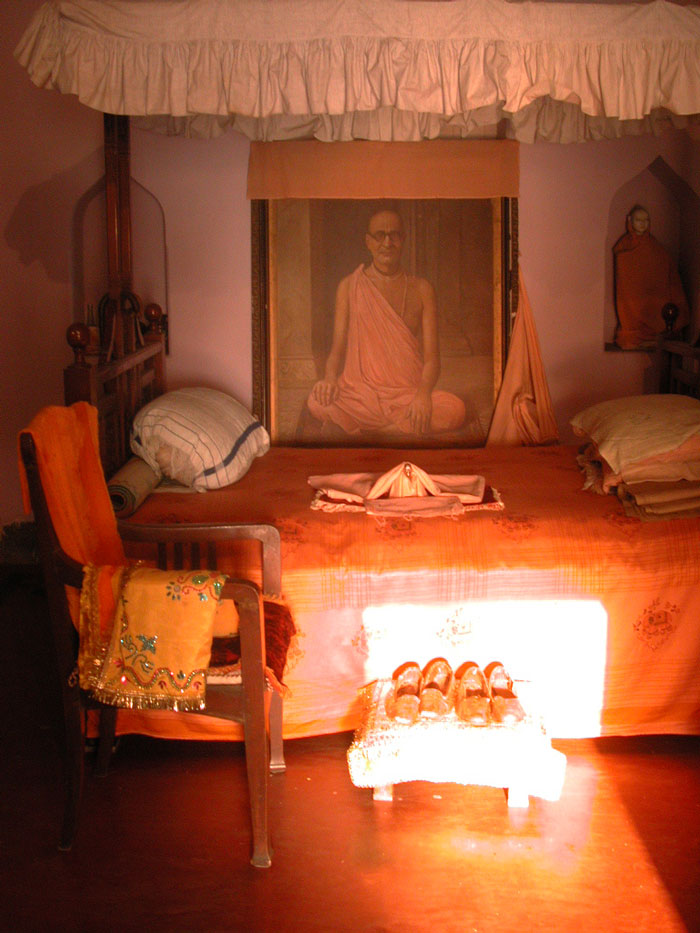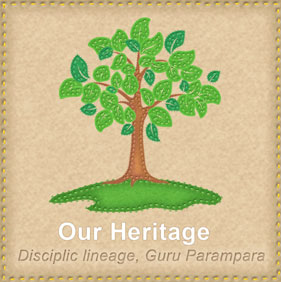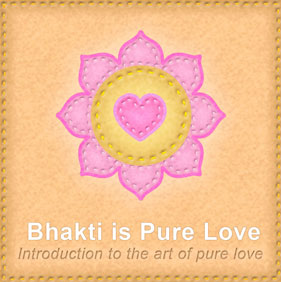Śrīla Prabhupāda’s 1932 Vraja-maṇḍala Parikramā and
His Dissemination of Rūpānuga Conceptions
Śrīla Bhaktisiddhānta Sarasvatī Ṭhākura Prabhupāda’s arrival in Mathurā for a month long Śrī Vraja-maṇḍala Parikramā and excerpts from his hari-kathā at that time
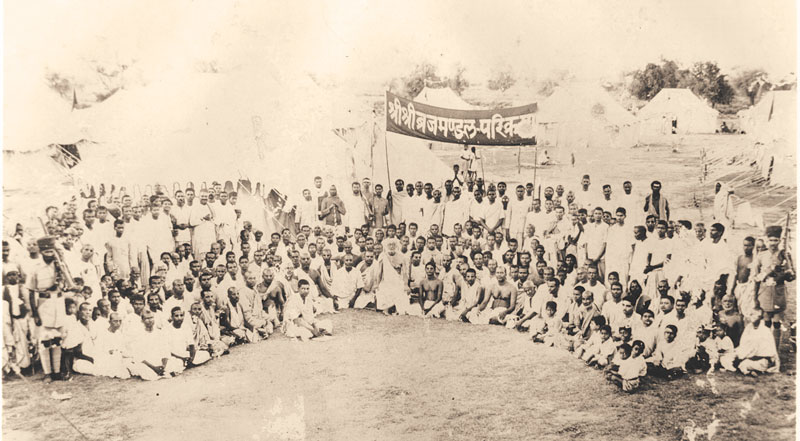
From the 1932 edition of the weekly Gauḍīya, we obtain the following information:
On Saturday, 1 October 1932, oṁ viṣṇupāda Śrī Śrīla Bhaktisiddhānta Sarasvatī Gosvāmī Prabhupāda, the foremost of śrī rūpānuga commanders, accompanied by his associates, departed from Howrah Station for Śrī Mathurā via the Delhi Express, to lead Śrī Vraja-maṇḍala parikramā.
On 2 October 1932, the Delhi Express reached Hathras Junction. From there, Śrīla Prabhupāda traveled in the Śrī Gauḍīya Maṭha’s car, while the remaining devotees journeyed in two buses, travelling the 32 miles westward to Mathurā.
Arrangements were made for Śrīla Prabhupāda to stay near the Mathurā Cantt Railway Station at the Śrī Baladeva Vilāsa Bhavan, located close to Dampier Park. Śrīla Prabhupāda had already reached there by car. As soon as the devotees arrived, Śrīla Prabhupāda began a discourse on śrīkṛṣṇānuśīlana (the cultivation of devotional service to Śrī Kṛṣṇa).
Śrīla Prabhupāda said, “Śrīla Rūpa Gosvāmī Prabhu did not speak of viṣṇu-anuśīlana (the cultivation of devotional service to Viṣṇu) or nārāyaṇa-anuśīlana (or to Nārāyaṇa) but rather emphasized only kṛṣṇānuśīlana. There can be no such thing as brahmānuśīlana (the practice of realizing the impersonal brahma), unless the term brahma specifically indicates the Supreme Lord. Paramātmānuśīlana (the practice of realizing the Supersoul) also is not kṛṣṇānuśīlana. It completely lacks the conception of the anuśīlana (practice) and that of the anuśīlanakārī (practitioner). To engage in kṛṣṇānuśīlana, it is essential to first engage in kārṣṇānuśīlana (the practice of following in the footsteps of the devotees of Kṛṣṇa). Without kārṣṇānuśīlana, kṛṣṇānuśīlana is not possible. Only when kṛṣṇānuśīlana and kārṣṇānuśīlana is performed with a favourable attitude does it produce the fruit of prema. A competitive attitude towards kārṣṇa (the devotees of Kṛṣṇa), seeing them with mundane mindset as ordinary humans is not kṛṣṇānuśīlana.”
During this Vraja-maṇḍala parikramā, arrangements were made for numerous pilgrims’ accommodation. Tents were set up on the vacant land in front of Śrī Baladeva Vilāsa Bhavan at Dampier Park, Mathurā.
On the evening of the 3rd, 4th, and 5th October, 1932, at his place of stay in Mathurā, Śrīla Prabhupāda had his devotees perform kīrtana of the songs of the mahājanas, which are filled with the heartfelt prayers and aspirations of liberated souls. Through this, he revealed that the sole goal of every sādhaka should be a yearning for perfection (siddhi-lālasā), following the eradication of unwanted desires (anartha-nivṛtti). In accordance with Śrīla Prabhupāda’s selection, devotees sang kīrtanas composed by Śrīla Narottama dāsa Ṭhākura and Śrīla Bhaktivinoda Ṭhākura.
On 4 October, these kīrtanas included:
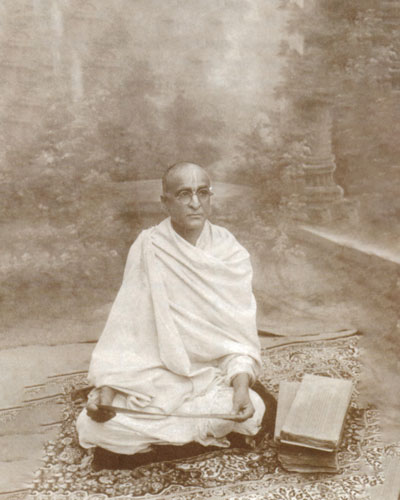 (1) hari hari kabe habo vṛndāvana vasī
(1) hari hari kabe habo vṛndāvana vasī
nirakhibo nayane yugala-rūpa-rāśi
O Śrī Hari, Śrī Hari, when will I become a resident of Vṛndāvana? When, with my own eyes, will I see the abundant beauty of the Divine Couple?
(2) rādhā-kṛṣṇa sevõ muĩ jīvane maraṇe
tā̃ra sthāna, tā̃ra līlā dekhõ rātri dine
I will serve Śrī Śrī Rādhā and Kṛṣṇa during life and after death. I will see, day and night, Their pastimes and the places of those pastimes.
On 5 October, the kīrtanas included:
(1) hari hari! āra kabe pālaṭibe daśā?
e saba kariyā vāme, ĵābo vṛndāvana dhāme,
ei mane kariyāchi āśā
When will I renounce all material impediments and go to Vṛndāvana-dhāma?
O Lord Hari, Lord Hari, when will my life change in this way? In my mind I am harbouring this hope.
(2) dekhite dekhite, bhulibo vā kabe, nija-sthūla-paricaya
nayane heribo, vraja-pura-śobhā, nitya cid-ānanda-maya
When will I suddenly leave this plane of my gross bodily identity far behind completely forgetting about all these false external affairs and will behold the exquisite beauty of the transcendental realm of Vraja, which is eternally pervaded with conscious bliss?
On 6 October, the kīrtanas included:
(1) rādhā-kunḍa-taṭa-kuñja-kuṭīra
govardhana-parvata, yāmuna-tīra
The cottage in the grove on the banks of Radha-kunda, the great Govardhana Hill, the banks of the Yamunā.
(2) yamunā-puline, kadamba-kānane, ki herinu sakhi! āja
śyāma vaṁśīdhārī, maṇi-mañcopari, kare līlā rasarāja
On the bank of the Yamunā, in the Kadamba forest, O friend, what did I see today? Śyāma, who carries a flute is seated upon a jewelled platform, performing His pastimes as the king of all rasas.
The weekly Gauḍīya further reported:
The 84 kosa Vraja Mandala parikramā, under the leadership of the current exalted president of the Śrī Śrī Viśva-vaiṣṇava-rāja-sabhā (World Assembly of Vaiṣṇavas), paramahaṁsaparivrājakācārya oṁ viṣṇupāda Śrī Śrīmad Bhaktisiddhānta Sarasvatī Gosvāmī Prabhupāda, commenced on Sunday 9 October 1932, on the occasion of Lord Śrī Rāmacandra’s Vijaya Utsava (celebration of His journey for victory) and the appearance day of Śrī Madhvācārya.
On the first and second days of the Vraja Mandala parikramā (9 and 10 October 1932), the pilgrims, under the guidance of oṁ viṣṇupāda Śrī Śrīla Bhaktisiddhānta Sarasvatī Gosvāmī Prabhupāda, performed parikramā of Mathurā amidst śravaṇa and kīrtana, while visiting various sacred sites marked by the footprints of Śrīman Mahāprabhu. At the forefront of the gloriousparikramā procession was the deity of Śrī Kṛṣṇa Caitanya Mahāprabhu, majestically enthroned on a beautifully decorated siṁhāsana (throne). Śrīla Prabhupāda followed behind Him, and after Śrīla Prabhupāda, there was a long saṅkīrtana group. In this way, they joyfully began parikramā of Śrī Mathurā Purī. The sweet sounds of various bands, mṛdaṅgas, and karatālas echoed in all directions. The sight was extraordinary, with beautifully adorned horses, flags, and long garlands of flowers adding to the grandeur of the magnificent jhaṅkīs (floats). Witnessing this splendour invoked memories of Śrī Kṛṣṇa’s manifest pastimes and brought to mind the glorious heritage of ancient India. On that day, as the pilgrimsloudly performed śrī harināma saṅkīrtana, they visited and had darśana of various līlā-sthalīs such as Kaṁsa-ṭīlā (where Kaṁsa was slain), Viśrāma-ghāṭa, Śrī Kṛṣṇa-janmasthāna (the birthplace of Śrī Kṛṣṇa), Kaṁsa-kārāgāra (Kaṁsa’s prison) and Ādi Keśava.
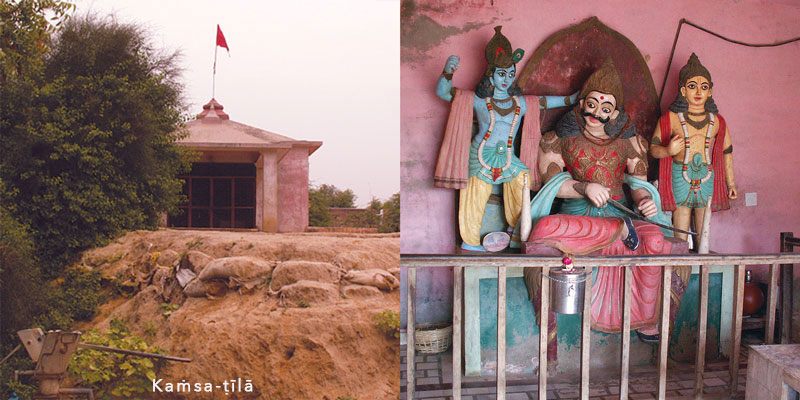
On another occasion towards the end of month long Kārtika parikramā, on the tenth day of the waxing moon, the grand parikramā procession visited a place near Kaṁsa-ṭīlā in Mathurā city. At that time, the tumultuous sound of the loud chanting of the holy names, which destroys impersonal conceptions of the Absolute, echoed in all four directions. During the four-day festival celebrated on this hill (Kaṁsa-ṭīlā) by the local residents, a celebration was held on the occasion of Śrī Gopāṣṭamī. On the very next day, the navamī of the waxing moon, a dramatic enactment of Śrī Kṛṣṇa’s pastime of slaying the impersonalist Kaṁsa was performed at that very site.
In Vaikuṇṭha, the Lord is unborn (ajanmā), but in Mathurā, that unborn Lord took birth. Therefore, Mathurā is superior even to Vaikuṇṭha. The impersonalist sect met its destruction here, Kaṁsa being the personification of that impersonalism. The followers of Kaṁsa, the smārta (ritualistic orthodox) sect, were also vanquished here. Rajak, the washerman (mentioned in Śrīmad-Bhāgavatam10.41.32–38), symbolized that karma-bound smārta tradition.
Sattvaṁ viśuddhaṁ vasudeva-śabditaṁ – viśuddha-sattva is known by the name vasudeva. This concept was revealed in Mathurā. The term vāsudeva is a more appropriate term for the scientific understanding of the Supreme Personality of Godhead. Complete Godhood is manifested as the Lord of Dvārakā, a higher degree of Godhood in the Lord of Mathurā, and the highest manifestation of Godhood in the Lord of Vraja Gokula.
Śrī Kṛṣṇa and Śrī Balarāma came to Mathurā to slay Kaṁsa. Kaṁsa was an impersonalist. On the basis of his own physical strength, he did not want to accept the eternality of the Bhagavān’s name, form, qualities, associates, and pastimes.
In this very Mathurā, devotees beheld Śrī Kṛṣṇa, the sole object (viṣaya) of all twelve rasas, in different ways according to their respective rasa:
mallānām aśanir nṛṇāṁ nara-varaḥ strīṇāṁ smaro mūrtimān
gopānāṁ sva-jano ‘satāṁ kṣiti-bhujāṁ śāstā sva-pitroḥ śiśuḥ
mṛtyur bhoja-pater virāḍ aviduṣāṁ tattvaṁ paraṁ yogināṁ
vṛṣṇīnāṁ para-devateti vidito raṅgaṁ gataḥ sāgrajaḥ
Śrīmad-Bhāgavatam (10.43.17)
“O Parīkṣit, when Śrī Kṛṣṇa, the embodiment of all rasas, entered the wrestling arena with His brother, Śrī Balarāma, various people present regarded Kṛṣṇa in different ways according to their respectiverasa, and they also experienceed that particular rasa. The huge wrestlers witnessed Kṛṣṇa to be as hard as a lightning bolt; the young women, possessing a high degree of madhura-rasa, saw Him as Cupid personified, and within their heart of hearts they became absorbed in thinking of Him with amorous intentions. The ordinary men regarded Him as jewel-like among men, and the gopas recognized Him as their relative. The impious rulers considered Him to be a severe chastiser of the wicked; and the older men and ladies, who were like His father and mother, viewed Him as their most beautiful child. Kaṁsa, the king of the Bhojas, knew Him as time personified, or death; the unintelligent materialists saw Him as the universal form; the yogīs as the Absolute Truth, and the Vṛṣṇis, who are devotees and lovingly disposed to the Lord, honoured Him as their supreme worshipable deity.”
The renowned advocate of Mathurā, Rāmadayāla Chaube, organized a series of discourses on behalf of the Viśva-prema-maṇḍala on 8, 9, and 10 November 1932, in the city of Mathurā. Under the presidency of Śrīla Prabhupāda, on 8 November, Śrīmad Bhakti Hṛdaya Vana Mahārāja delivered a lecture in English on “Śrī Kṛṣṇa and Mathurā”. On 9 November, Śrīmad Bhakti Vilāsa Gabhasthanemi Mahārāja delivered a speech in Hindi on “Sanātana Dharma and Bhakti”. On 10 November, Śrīmad Bhakti Pradīpa Tīrtha Mahārāja gave a lecture in English on “Śrī Kṛṣṇa Caitanya and Prema”. As the president of the gathering, Śrīla Prabhupāda especially elaborated on all these topics in his address.
Excerpts from Śrīla Bhaktisiddhānta Sarasvatī Ṭhākura Prabhupāda’s hari-kathā during Śrī Vraja-maṇḍala parikramā, in which he addresses the dire condition of society – a lacking in the application of paramārtha dharma – and his desire to establish, within Mathurā-maṇḍala, the Gauḍīya sampradāya’s conceptions and subsequent practices
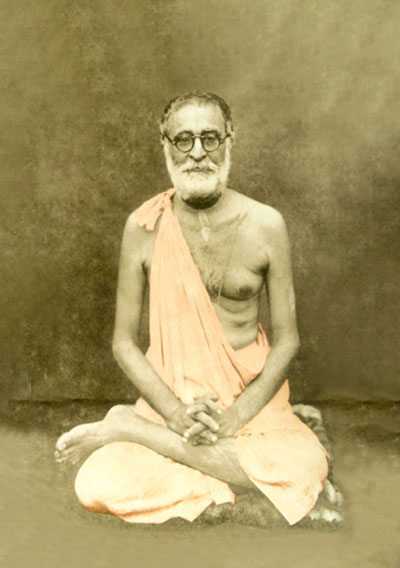 (1) Significant obstacles are being experienced in the practice of the transcendental religion (paramārtha-dharma), because the teachings of Śrīman Mahāprabhu and the secrets of Gauḍīya bhajana contained within Bhakti-rasāmṛta-sindhu and Śrī Caitanya-caritāmṛta, which delineate Gauḍīya Vaiṣṇava dharma, are not being propagated by the Gauḍīya Vaiṣṇavas among the residents of Vraja-maṇḍala.
(1) Significant obstacles are being experienced in the practice of the transcendental religion (paramārtha-dharma), because the teachings of Śrīman Mahāprabhu and the secrets of Gauḍīya bhajana contained within Bhakti-rasāmṛta-sindhu and Śrī Caitanya-caritāmṛta, which delineate Gauḍīya Vaiṣṇava dharma, are not being propagated by the Gauḍīya Vaiṣṇavas among the residents of Vraja-maṇḍala.
(2) The dharma propagated by Śrīman Mahāprabhu, as well as the devotional conduct established by Śrī Rūpa Gosvāmī and Śrī Sanātana Gosvāmī, now need to be widely promoted within Mathurā-maṇḍala, because nowadays, we see that most of the worshippers of Kṛṣṇa within in the Mathurā-maṇḍala are worshippers in name only. Although the Gauḍīya Vaiṣṇavas experience great joy upon witnessing efforts to worship Kṛṣṇa in the seven prominent temples of Vṛndāvana, it is essential that they remain vigilant, so that any mundane ideology, in regard to the devotional service of Śrī Kṛṣṇa, does not infiltrate and contaminate the teachings of Gauḍīya Vaiṣṇava dharma.
(3) By the desire of Śrīman Mahāprabhu, the pure devotional conduct (śuddha-bhakti-sadācara) refined and exhibited by Śrīla Rūpa and Śrīla Sanātana became, in later times, either diluted in some places by impurity or reduced to a thin stream, with a small number of Gauḍīya Vaiṣṇavas practising in solitude here and there. As a result, it remained unknown to the common people. Śrīla Sanātana Gosvāmī, the propagator of pure devotional conduct and the promoter of Vaiṣṇava-smṛti, along with Śrīla Gopāla Bhaṭṭa Gosvāmī, compiled a Vaiṣṇava-smṛti [Hari-bhakt-vilāsa] to establish śuddha-bhakti-sadācara in regions devoid of devotion. Seeing these teachings disregarded, the Gauḍīya bhaktas feel deeply distressed.
(4) The people of North India, due to their reverence for karma-kāṇḍa (ritualistic activities) and jñāna-kāṇḍa (the pursuit of knowledge), and due to anyābhilāṣa (having desires other than for pure bhakti), face obstacles in understanding the conduct of pure devotion (bhakti-sadācāra). The true Vrajavāsīs are eternally perfected souls (nitya-siddha), free from delusion and devoted to pure bhakti-sadācāra. They are simple, guileless friends of the Vaiṣṇavas and are their well-wishers. But those who, in the guise of being a Vrajavāsī, attempt to enter Vraja with deceitful motives, being descendants or representatives of Aghāsura, Bakāsura, Pūtanā, and Kaṁsa, bring obstacles to the Govardhana-pūjā performed by Nanda-nandana. Go [means “cow”, “cowherd people” or “senses”, but it] also refers to speech (vāṇī). Vardhana [which means “to expand”] here means the expansion of speech. Satisfying Kṛṣṇa’s senses, or kṛṣṇendriya-tarpaṇa, happens only through the propagation of Śrī Nanda-nandana’s divine message. The genuine Vrajavāsīs are always engaged in kṛṣṇendriya-tarpaṇa. Those who create obstacles in the propagation of Śrī Kṛṣṇa’s divine message instead of assisting in Govardhana-pūjā, are foolish and immoral.
(5) The term “Vrajavāsī” refers only to transcendentally realized servants of Śrī Hari. It does not apply to those who are immersed in worldly indulgence and opposed to the devotees of the Lord. If a sādhaka does not follow in the footsteps of Vraja’s rāgātmika-jana, such as Citraka, Patraka, Śrīdāma, Subala, and Nanda, Yaśodā, or of Lalitā-Viśākhā and other gopīs, and does not become their follower, then neither can he truly reside in Vraja, nor can he attain genuine anurāga (deep loving attachment to Kṛṣṇa). Only the nitya-siddha Vrajavāsīs are rāgātmika-jana.
(6) It is obligatory to follow the bhāva of a particular Vrajavāsī and reside constantly in Śrī Vrajabhūmi. One will inquire about the kathā pertaining to one’s particular rasa. Those desiring madhura-rasa (the mood of amour) approach those Vrajavāsīs who are immersed in that mood, such as Lalitā, Viśākhā, Śrī Rūpa Mañjarī and others. To truly become a Vrajavāsī, exclusive and unwavering service to the nitya-siddha Vrajavāsīs is essential.
(7) To search for Kṛṣṇa, we must first seek out one who is kārṣṇa (a devotee of Kṛṣṇa). The difficulties we encounter are due to not taking shelter of the lotus feet of a pure Vaiṣṇava and also due to considering a non-Vaiṣṇava to be a Vaiṣṇava.
(8) At present, we are wandering here and there, constantly thinking, “Money, money.” We are engrossed in thoughts like, “What actions will bring pious credits? How many times do I need to perform ācamana and saṅkalpa at holy places to attain various pleasures and the prosperity of heaven? How often do we visit a particular place to satisfy the curiosity of our eyes?” The narrations of the Bhāgavatam have not entered our ears. None of us wants to know about Kṛṣṇa’s narrations. This is because to know the narrations about Kṛṣṇa, we must approach a kārṣṇa, and a kārṣṇa will never speak about fulfilling our sensory desires.
(9) Those who consider liberation to be enjoyment cannot trample upon it, and thus they cannot attain the position of a true devotee. Pure devotion (suddha-bhakti) is the highest form of devotion. Such devotion is free from the four types of selfish desires: occupational duty (dharma), wealth (artha), sense gratification (kāma), and liberation (mokṣa). The hari-kathā spoken by the Six Gosvāmīs in the land of Vraja was devoid of even the slightest scent of such desires.
(10) Let no one think that the Supreme Lord can be served with the gross body, for hari-bhajana is not performed with gross senses such as the physical eyes, ears, and other organs, nor is it performed with the subtle senses such as the mind. In this world, however, these very senses are our support. Śrīla Rūpa Gosvāmī Prabhu has therefore shown us a skill by which the senses can become spiritualized and attain the qualification to enter the transcendental realm. When the senses, by their own effort, try to enter the transcendental realm, they fail. Hence, the ārohavādīs (adherents of the ascending process) cannot perceive the transcendental truth (aprākṛta-tattva). Only when the senses become illuminated by the descending grace from the transcendental realm, which bestows an inclination to serve, do they gain the capacity to realize transcendental subjects. At that point, the outward tendency of the senses ceases. Illuminated by the inclination to serve, the senses attain the qualification to enter the inner sanctum of the transcendental realm.
(11) The perspective of those who try to grasp transcendental concepts through material reasoning is impure and incomplete. They cannot enter the transcendental realm.
sarvopādhi-vinirmuktaṁ / tat-paratvena nirmalam
hṛṣīkeṇa hṛṣīkeśa- / sevanaṁ bhaktir ucyate
Śrī Nārada Pañcarātra (1.1.12)
[Bhakti means engaging one’s senses and mind in the service of Śrī Kṛṣṇa with the sole purpose of pleasing Him. It is uncontaminated by speculative knowledge or fruitive activities. When the jīva renders service to Hṛṣīkeśa, the master of the senses, one’s senses become spiritualized and one is freed from all material designations.]
In regard to the Vrajavāsīs, there is no consideration of material designation. This is the fundamental difference between the Vrajavāsīs and karma-bound smārtas. The Vrajavāsīs are naturally free from all designations, exclusively devoted to Kṛṣṇa, and pure. As long as the mind is entangled in designations, it is impossible to truly perceive a spiritually realized soul (a paramārthī) or a pure devotee (a bhāgavata-jana). If, while standing on the land of Mathurā, one perceives that land to be composed of water, mud, and stones, then such perception falls under the purview of the verse yasyātma-buddhiḥ kuṇape (Śrīmad-Bhāgavatam 10.84.13). [One who considers this corpse-like body, comprised of the three elements – vata, pita, and kapha – to be his real self; who regards his wife, children, and others as his very own; who considers mundane forms made of earth, stone, or wood to be worshipable; and who regards mere water to be a place of pilgrimage – but who does not consider the bhagavad-bhaktas to be more dear than his very self, to be his very own, to be worshipable, and to be places of pilgrimage; such a person, though human, is no better than an ass among animals.] Just as adding a bit of lime to milk renders it unfit for consumption, similarly, mixing any material designation with pure devotion renders it unfit to be accepted by Śrī Kṛṣṇa.
(12) Where transcendental consciousness has not been awakened by hearing the divine words of the exalted spiritual master (atimartya ācārya), there, anartha (misinterpretation) arises from artha (the true meaning). Only those who consider a life immersed in the Ganges – in the form of surrendering to and following the words of śrī guru-pādapadma – understanding such a life to be the highest ideal, can receive the mercy of Śrī Guru and Gaurāṅga and thus truly attain an invitation to circumambulate the supramundane (aprākṛta) realm of Vraja.
Śrīla Bhaktisiddhānta Sarasvatī Ṭhākura Prabhupāda’s Śrī Vraja-maṇḍala parikramā – some highlights
(1) The enlivening words of an atimartya mahāpuruṣa Śrīla Bhaktisiddhānta Sarasvatī Ṭhākura Prabhupāda, constantly reverberated throughout that Śrī Vraja-maṇḍala parikramā. At every moment, the purpose and significance of the parikramā were revealed through narrations filled with uddīpana (stimuli) that highlighted the glories of various sacred places. On one hand, the servitor community of the ācārya demonstrated and explained complete adherence to the principle of anugatya-dharma(constantly being under guidance). Their services were enriched by discussions recalling Śrīman Mahāprabhu and His conduct. On the other hand, Śrīla Prabhupāda, an associate of Gaura and a genuine resident of Vraja, was revealing the eternal nature of Śrī Vraja-bhūmi to everyone through the nectarean waves of his śrī hari-kathā, which flowed ceaselessly.
(2) By following in the footsteps of Śrī Gaurāṅga’s intimate associate, Śrīla Prabhupāda, a mahā-bhāgavata immersed in loving devotion to Śrī Gaura, and by hearing Śrī Caitanya’s divine message from him, we came to understand that the sole purpose of Vraja-maṇḍala parikramā was to, free from offences, strive for entrance into the five topmost limbs of sādhana-bhakti, especially nāma-saṅkīrtana. During Śrī Vraja-maṇḍala parikramā, the nectarean festival of hari-kathā coming from the lotus lips of Śrī Gaura’s associates was truly rare and unparalleled.
(3) Śrīla Prabhupāda would sometimes narrate hari-kathā in Hindi, sometimes in Bengali, and sometimes in English, and describe the glories of Śrīman Mahāprabhu and the profound essence of vraja-bhajana. Those who performed parikramā with an absorbed and focused heart, being immersed in hearing and chanting the divine message of Śrī Caitanya, became eligible to simultaneously realize the very form of magnanimity within the ninefold bhakti-rasa (navadha-bhakti) in the nine islands of Navadvīpa and the very form of sweetness within the twelve nectarean rasas of the emporium of all rasa (akhila-rasāmṛta-mūrti) in the twelve forests of Vraja.
(4) By the order of Śrīla Prabhupāda, various sannyāsīs, brahmacārīs, and gṛhastha devotees delivered discourses and performed kīrtana on different topics, keeping the purpose of the parikramāvibrant and alive.
(5) The primary objective of the parikramā was to serve śrī guru and the Vaiṣṇavas, not to wander through various places merely to satisfy one’s curiosity. Śrīman Mahāprabhu demonstrated this ideal in Vṛndāvana through Balabhadra Bhaṭṭācārya, showing that without serving śrī guru and the Vaiṣṇavas, one cannot truly perceive the dhāma with one’s material eyes or through one’s physical effort. If someone, due to being absorbed in service to guru and Kṛṣṇa, is unable to take darśana of certain places during the parikramā, their parikramā is still considered complete. Those who prioritize wandering and sightseeing over service, however, have failed to grasp the true essence of parikramā.
[To be continued in Part-3]
All glories to Śrī Mathurā-dhāma!
All glories to Śrī Keśavajī Gauḍīya Maṭha!
All glories to the Gauḍīya-rūpānuga-sārasvata Guru Paramparā!
All glories to nitya-līlā- praviṣṭa oṁ viṣṇupāda aṣṭottara-śata-śrī
Śrīmad Bhaktisiddhānta Sarasvatī Ṭhākura Prabhupāda!
All glories to nitya-līlā- praviṣṭa oṁ viṣṇupāda aṣṭottara-śata-śrī
Śrīmad Bhakti Prajñāna Keśava Gosvāmī Mahārāja!
All glories to nitya-līlā- praviṣṭa oṁ viṣṇupāda aṣṭottara-śata-śrī
Śrīmad Bhaktivedānta Nārāyaṇa Gosvāmī Mahārāja!
All glories to their dedicated servants!
Gaura premānande!
Presented by: Mādhava-priya dāsa and Amala-kṛṣṇa dāsa
Source: The Weekly Gauḍīya, Year 11.
Acknowledgements: Pūjā Dāsī
Translated from Śrī Śrī Bhāgavata Patrikā, Year-20 Issue 5-12
by the Rays of The Harmonist team

